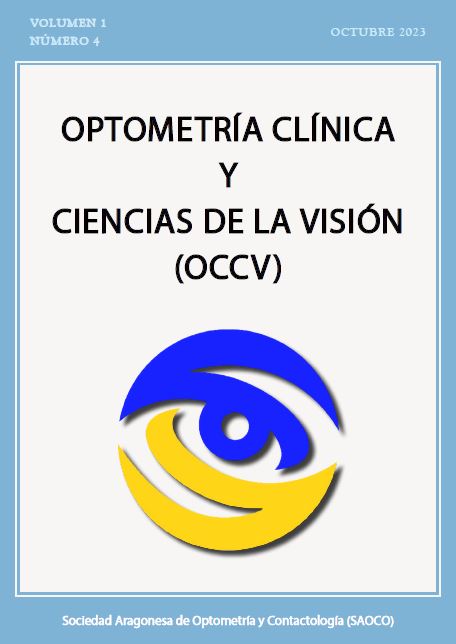Visual Performance of the Presbyopic Patient with Multifocal Contact Lenses
DOI:
https://doi.org/10.71413/5qavgd28Keywords:
Presbyopia, Contrast Sensitivity, Visual acuity, Contact LensesAbstract
Relevance: This literature review highlights the importance of visual performance in presbyopic patients using multifocal Contact Lenses.
Summary: A literature review of publications from recent years was conducted, focusing on the visual performance of presbyopic patients using multifocal contact lenses, summarizing studies that meet predefined inclusion criteria. Bibliographic search was performed using descriptors and Boolean operators, and these results were screened based on inclusion and exclusion criteria to obtain final outcomes. Searches were conducted using descriptors, ensuring they appeared in the title or abstract of the article. To refine the search on the PubMed platform, additional filters, such as inclusion and exclusion criteria, were applied. A total of 78 results were obtained initially. After applying inclusion and exclusion criteria, the number of articles was reduced to 15 results.
Multifocal Contact Lenses (CLs) are a good optical correction alternative for presbyopia, as evidence confirms that Visual Acuity (VA) is good and there are no differences in VA compared to progressive glasses. Contrast Sensitivity (CS) is also not affected when using multifocal CLs, and from defocus curves, it can be inferred that the patient has a good focused space for everyday tasks. However, we must consider additions, as higher additions result in lower VA and CS values. Therefore, the higher the addition of our patient, the lower the VA and CS. Compared to monovision, multifocal CLs provided better visual performance without the reduction in stereopsis produced by monovision technique.
References
Hutchins B, & Huntjens B. Patients' attitudes and beliefs to presbyopia and its correction.J Optom [Internet].2021; 14(2): 127-32. Disponible en: DOI: https://doi.org/10.1016/j.optom.2020.02.001
http://dx.doi.org/10.1016/j.optom.2020.02.001 DOI: https://doi.org/10.1016/j.optom.2020.02.001
Yazdani N, Khorasani AA, Moghadam HM, Yekta AA, Ostadimoghaddam H, & Shandiz JH. Evaluating Three Different Methods of Determining Addition in Presbyopia. J Ophthalmic Vis Res [Internet]. 2016; 11(3):277–81. Disponible en: http://dx.doi.org/10.4103/2008-322X.188387 DOI: https://doi.org/10.4103/2008-322X.188387
Balgos MJTD, Vargas V,Alió JL. Correction of presbyopia: An integrated update for the practical surgeon. Taiwan J Ophthalmol [Internet]. 2018; 8(3):121–40. Disponible en: http://dx.doi.org/10.4103/tjo.tjo_53_18 DOI: https://doi.org/10.4103/tjo.tjo_53_18
Mohamud, A., Erichsen, J., Kessel, L., Holm, L., & Larsen, M. Ugeskrift for laeger, 2019; 181(5), V06180461.
Wolffsohn, JS, Davies LN.Presbyopia: Effectiveness of correction strategies. Prog Retin Eye Res [Internet]. 2019; 68: 124–43. Disponible en: DOI: https://doi.org/10.1016/j.preteyeres.2018.09.004
http://dx.doi.org/10.1016/j.preteyeres.2018.09.004 DOI: https://doi.org/10.1016/j.preteyeres.2018.09.004
Vedhakrishnan S, Vinas M, Benedi-Garcia C, Casado P, Marcos S. Visual performance with multifocal lenses in young adults and presbyopes. PloS One [Internet].2022; 17(3): e0263659.Disponible en: http://dx.doi.org/10.1371/journal.pone.0263659 DOI: https://doi.org/10.1371/journal.pone.0263659
Remón L, Pérez-Merino P, Macedo-de-Araújo RJ, Amorim-de-Sousa AI, González-Méijome JM.Bifocal and Multifocal Contact Lenses for Presbyopia and Myopia Control. J Ophthal [Internet]. 2020; 2020:8067657. Disponible en: http://dx.doi.org/10.1155/2020/8067657 DOI: https://doi.org/10.1155/2020/8067657
Renna A, Alió JL, Vejarano LF. Pharmacological treatments of presbyopia: a review of modern perspectives. Eye Vis (Lond) [Internet]. 2017; 4(1): 3. Disponible en: http://dx.doi.org/10.1186/s40662-017-0068-8 DOI: https://doi.org/10.1186/s40662-017-0068-8
Katz JA, Karpecki PM, Dorca A, Chiva-Razavi S, Floyd H, Barnes E et al. Presbyopia - A Review of Current Treatment Options and Emerging Therapies. Clin Ophthal [Internet]. 2021; 15, 2167–78. Disponible en: http://dx.doi.org/10.2147/opth.s259011 DOI: https://doi.org/10.2147/OPTH.S259011
Legras R, Benard Y, Rouger H. Through-focus visual performance measurements and predictions with multifocal contact lenses. Vis Res [Internet]. 2010; 50(12):1185–93. Disponible en: http://dx.doi.org/10.1016/j.visres.2010.04.001 DOI: https://doi.org/10.1016/j.visres.2010.04.001
Llorente-Guillemot A, García-Lazaro S, Ferrer-Blasco T, Perez-Cambrodi RJ, Cerviño A. Visual performance with simultaneous vision multifocal contact lenses. Clin Exp Optom [Internet]. 2012; 95(1):54–9. Disponible en: http://dx.doi.org/10.1111/j.1444-0938.2011.00666.x DOI: https://doi.org/10.1111/j.1444-0938.2011.00666.x
Fernandes PR, Neves HI, Lopes-Ferreira DP, Jorge JM, González-Meijome JM. Adaptation to multifocal and monovision contact lens correction. Optom Vis Sci [Internet]. 2013; 90(3): 228–35. Disponible en: DOI: https://doi.org/10.1097/OPX.0b013e318282951b
http://dx.doi.org/10.1097/OPX.0b013e318282951b DOI: https://doi.org/10.1097/OPX.0b013e318282951b
García-Lázaro S, Albarrán-Diego C, Ferrer-Blasco T, Radhakrishnan H, Montés-Micó R. Visual performance comparison between contact lens-based pinhole and simultaneous vision contact lenses. Clin Exp Optom [Internet]. 2013; 96(1): 46–52. Disponible en: http://dx.doi.org/10.1111/j.1444-0938.2012.00791.x DOI: https://doi.org/10.1111/j.1444-0938.2012.00791.x
Piñero DP, Carracedo G, Ruiz-Fortes P, Pérez-Cambrodí RJ. Comparative analysis of the visual performance and aberrometric outcomes with a new hybrid and two silicone hydrogel multifocal contact lenses: a pilot study. Clin Exp Optom [Internet]. 2015; 98(5): 451–58. Disponible en: DOI: https://doi.org/10.1111/cxo.12299
http://dx.doi.org/10.1111/cxo.12299 DOI: https://doi.org/10.1111/cxo.12299
Sha J, Bakaraju RC, Tilia D, Chung J, Delaney S, Munro A, et al. Short-term visual performance of soft multifocal contact lenses for presbyopia. Arq Bras Oftalmol [Internet]. 2016; 79(2): 73–7. Disponible en: http://dx.doi.org/10.5935/0004-2749.20160023 DOI: https://doi.org/10.5935/0004-2749.20160023
Tilia D, Munro A, Chung J, Sha J, Delaney S, Kho D, et al. Short-term comparison between extended depth-of-focus prototype contact lenses and a commercially-available center-near multifocal. J Optom [Internet]. 2017; 10(1): 14–25. Disponible en: http://dx.doi.org/10.1016/j.optom.2016.04.003 DOI: https://doi.org/10.1016/j.optom.2016.04.003
Bakaraju RC, Tilia D, Sha J, Diec J, Chung J, Kho D, et al. (2018). Extended depth of focus contact lenses vs. two commercial multifocals: Part 2. Visual performance after 1 week of lens wear. J Optom [Internet]. 2018; 11(1): 21–32. Disponible en: http://dx.doi.org/10.1016/j.optom.2017.04.001 DOI: https://doi.org/10.1016/j.optom.2017.04.001
Vinas M, Aissati S, Gonzalez-Ramos AM, Romero M, Sawides L, Akondi V, et al. Optical and Visual Quality With Physical and Visually Simulated Presbyopic Multifocal Contact Lenses. Transl Vis Sci Technol [Internet]. 2020; 9(10): 20. Disponible en: http://dx.doi.org/10.1167/tvst.9.10.20 DOI: https://doi.org/10.1167/tvst.9.10.20
Kamiya K, Iijima K, Hiraoka T, Takada K, Mori Y, Miyata, K. Comparison of Visual Performance and Patient Satisfaction After Multifocal Intraocular Lens Implantation and During Multifocal Contact Lens Wear After Monofocal Intraocular Lens Implantation: A Pilot Study. Ophthalmol Ther [Internet]. 2021; 10(4): 1119–28. Disponible en: http://dx.doi.org/10.1007/s40123-021-00414-6 DOI: https://doi.org/10.1007/s40123-021-00414-6
Hair LA, Steffensen EM, Berntsen DA. The Effects of Center-near and Center-distance Multifocal Contact Lenses on Peripheral Defocus and Visual Acuity. Optom Vis Sci [Internet]. 2021; 98(8): 983–94. Disponible en: DOI: https://doi.org/10.1097/OPX.0000000000001753
http://dx.doi.org/10.1097/OPX.0000000000001753 DOI: https://doi.org/10.1097/OPX.0000000000001753
Vedhakrishnan S, Vinas M, Aissati S, Marcos S. Vision with spatial light modulator simulating multifocal contact lenses in an adaptive optics system. Biomed Opt Express [Internet]. 2021; 12(5): 2859–72. Disponible en: DOI: https://doi.org/10.1364/BOE.419680
http://dx.doi.org/10.1364/BOE.419680 DOI: https://doi.org/10.1364/BOE.419680
Barcala X, Vinas M, Ruiz S, Hidalgo F, Nankivil D, Karkkainen T, et al. Multifocal contact lens vision simulated with a clinical binocular simulator. Cont Lens Anterior Eye [Internet]. 2022; 45(6): 101716. Disponible en: http://dx.doi.org/10.1016/j.clae.2022.101716 DOI: https://doi.org/10.1016/j.clae.2022.101716
Vedhakrishnan S, Vinas M, Benedi-Garcia C, Casado P, Marcos S. Visual performance with multifocal lenses in young adults and presbyopes. PloS One [Internet]. 2022; 17(3): e0263659.Disponible en: http://dx.doi.org/10.1371/journal.pone.0263659 DOI: https://doi.org/10.1371/journal.pone.0263659
Naroo SA, Nagra M, Retallic N. Exploring contact lens opportunities for patients above the age of 40 years. Contact Lens Anterior Eye [Internet]. 2022; 45(6): 101599. Disponible en: http://dx.doi.org/10.1016/j.clae.2022.101599 DOI: https://doi.org/10.1016/j.clae.2022.101599
Additional Files
Published
Issue
Section
Categories
License
Copyright (c) 2024 Dña. Miriam García Angulo (Autor/a)

This work is licensed under a Creative Commons Attribution-NonCommercial 4.0 International License.



